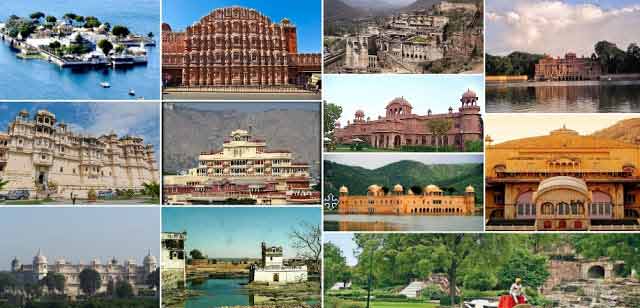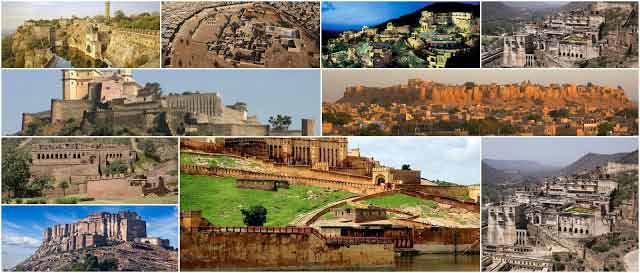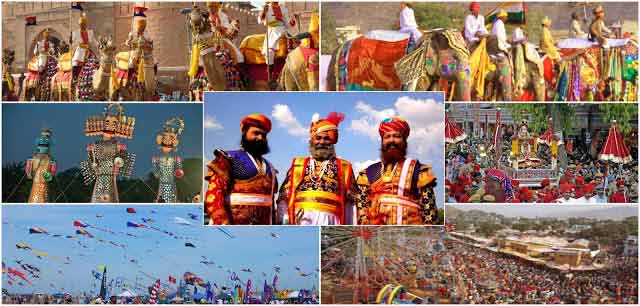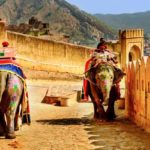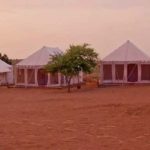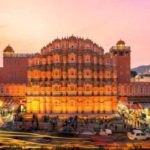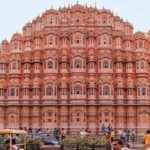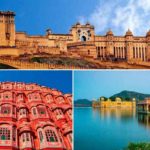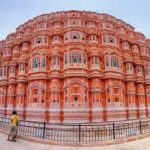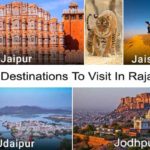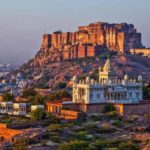Rajasthan is one of the most popular tourist destinations in India, for both domestic and international tourists. Rajasthan attracts tourists for its historical forts, palaces, art and culture. Every third foreign tourist visiting India also travels to Rajasthan as it is part of the Golden Triangle for tourists visiting India. Endowed with natural beauty and a great history, Rajasthan has a flourishing tourism industry. The palaces of Jaipur, lakes of Udaipur, and desert forts of Jodhpur, Bikaner & Jaisalmer are among the most preferred destinations of many tourists, Indian and foreign. Tourism accounts for eight percent of the state’s domestic product. Many old and neglected palaces andforts have been converted into heritage hotels. Tourism has increased employment in the hospitality sector. The main sweet of this place is ghewar.
This land is a colorful melange of massive forts, stunning palaces, diversecultures, delectable cuisines and warm people, set amidst a rugged yet inviting landscape. It is a land that has inspired me and countless others. Come tread on the sands of time. In Rajasthan you will find every hue in Nature’s grand palette – the red sands, the blue of royalty, the pink cities or the amber sunsets. Surrender yourself to the sounds of trinkets or the sounds of the all conquering wind. Sight and sounds that are far removed from any city. Sightsand sounds that will transport you into a folk lore. Music, art and dance is woven into every inch of this land I call paradise. You will find it carved in every grain of sand. Here you will find the past, the present and the future. You will find passion. You will find adventure. And you will find yourself. Come, walk into the unforgettable embrace of Rajasthan.
Look at the Best Rajasthan Tour Packages.
Rajasthan’s Top Palaces
1. Jag Mandir Royal Palace:
Jag Mandir is a palace built on an island in the Lake Pichola. It is also called the “Lake Garden Palace”. The palace is located in Udaipur city in the Indian state of Rajasthan. Its construction is credited to three Maharanas of the Sisodia Rajputs of Mewar kingdom. The construction of the palace was started in 1551 by Maharana Amar Singh, continued by Maharana Karan Singh (1620–1628) and finally completed by Maharana Jagat Singh I (1628–1652). It is named as “Jagat Mandir” in honour of the last named Maharana Jagat Singh. The royal family used the palace as a summer resort and pleasure palace for holding parties. The palace served as a refuge to asylum seekers on two separate occasions.
2. City Palace Udaipu:
The CityPalace stands tall over Pichola Lake, having served as an abode for the ruling royalty. Construction was begun by Maharana Udai Singh and was continued by successive Maharanas who incorporated several palaces and structures to the complex. Interestingly, each addition preserved the original style of the design. Visitors enter the palace through Bari Pol (the Big Gate) which leads one to Tripolia (the Triple Gate) where it was once a custom to distribute the Maharaja’s weight in gold and silver to his subjects. It now serves as the m in ticket office. The palace has numerous balconies, cupolas and towers that overlook Pichola Lake. The structure is just as beautiful inside as it is spectacular from the outside. Each palace is designed in a unique way, and decorations like mirrored tiles, paintings, glass work and ornamental tiles bring to life the opulence of the era. Today, the main section of the palace has been converted into a museum that houses a large collection of artifacts.
3. City palace Jaipur:
The ‘City Palace’ is one of the most famous tourist attractions in Jaipur, located in the heart of the city. Dating back to the 19th century, The city palace was built by Raja Sawai Jai Singh and the royal family still uses a section of the palace. The exquisite 19th century Mubarak Mahal or The Palace of Reception which used to serve as the reception area of royal guests was built by Madho Singh and is now converted into museum which show cases a bewildering array of royal costumes of the charismatic prince Sawai Madho Singh. Apart from the royal costumes, on display at the museum are some intriguing 15th century royal armory that have been very well preserved.
4. Hawa Mahal (Palace Of wind):
Built by Maharaja Sawai Pratap Singh for royal women to view the busy streets of Johari Bazaar, while staying veiled behind the jharokhas. Hawa Mahal is a pyramid-shaped facade with five stories. It has 953 small windows decorated with tiny lattice work. These pink sandstone windows commonly known as “Jharokhas” are constructed in such a style, that it looks like a giant honeycomb. The air circulation through windows represents the marvelous touch of Mughal designing, which keeps the Palace always cool. The small screened balconies and arched roofs with hanging cornices enhance the beauty of the Palace. The Pyramidal outline and replication of pattern makes it more attractive in appearance.
As a matter of fact, Hawa Mahal is believed to build for the women of the Royal Families, since they had to observe strict “purdah” syetem (veil over the face). The small windows and screened balconies serve the women to watch processions and different activities taking place on the main streets. In this manner, the women could enjoy a sense of freedom without showing themselves.
5. Jal Mahal Palace:
The palace architecture boasts of a typical Rajput and Mughal style which is quite similar to that of Amer Fort. Made in red sandstone, the palace is actually five-storied where only the top story is visible (rest are submerged under water).
6. Gajner Palace:
The palace is situated about 20kms from the city of Bikaner and is set up beside a beautiful lake called Gajner Lake. One has the opportunity to enjoy nature walks, boating and desert safaris near the palace.
7. Lalgarh Palace:
Another architectural delight in Bikaner is Lalgarh Palace. The palace also consists of a museum that is situated inside Ganga Niwas. Here one can see the Miniature Paintings that are related to Bikaner school of art, Terracota Wares and armors. There is also a library that has a good collection of Sanskrit Manuscripts written on parchments, plaques of silver, copper and gold. The artifacts belonging to Harappa civilization and Kushan and Gupta Age are also preserved here.
8. Fateh Prakash Palace Chittorgarh:
You can also visit Fateh Prakash Palace, which was built by Maharaja Fateh Singh in 1920. Built beautifully, the palace now has been converted into the government museum.
9. Padmini Palace Chittorgarh:
Built beside a pool, this is a magnificent palace. It was here that Rana Rattan Singh showed a glimpse of Rani Padmini to Allauddin Khilji. Rani Padmini stood in the Zenana Mahal, and her reflection was visible to Khilji in a mirror placed in the main hall. Khilji, after having a glimpse of the queen, was smitten by her beauty and with the passion to posses her invaded Chittaur.
10. Balsamand Lake palace:
BalsamandLake is a lake situated 5 km from Jodhpur on Jodhpur-Mandore Road. This lake is a popular picnic spot, built in 1159 AD by Gurjara-Pratihara rulers. It was designed as a water reservoir to provide water to Mandore. The lake has a length of one km, breadth of 50 m and a depth of 15 m. The Balsamand Lake Palace was built later as a summer palace on its shore. The lake
is surrounded by lush green gardens that house groves of trees like mango, papaya, pomegranate, guava and plum. Animals and birds like the jackal and peacock also call this place home.
11. City Palace Alwar:
The City Palace of Alwar is known as the Vinay Vilas Mahal. It is standing huge in the heart of Alwar City of Rajasthan. The City Palace, of Alwar, was built up by Raja Bakhtayar Singh in the year 1793. The building is a perfect example of Indo-Islamic architecture. The prehistoric city of Alwar is settled at the slopes of the Aravalli Hills has converted into a crowded trade center in recent times. But its rich history has left many examples through many temples, forts, tombs, gardens and palaces.
12. Garh Palace Bundi:
Maharao Balwant Singh started the construction of Garh Palace in Bundi. The Garh Palace is the complex of numerous palaces which were built by rulers of different times. Most of the palaces were built between the 17th and 18th centuries. After a long period of neglection Garh palace again gaining its recognition. Garh Palace is known for its artistic Rajput style architecture which can be easily seen in its Jharokhas and pillars. Among other palaces which are famous for their decoration like Chhatra Mahal, Phool Mahal and Badal Mahal, there is a somewhat separate Ummed Mahal, famously known as ‘Chitrashala‘. Chitrashala has fascinating pavilion and a gallery of miniature murals located on a raised platform above a garden platform. It has entrance from other side and no entry fee with 8 am to 5 pm timings.
Let’s check-out to Rajasthan Group Tour Packages.
Rajasthan’s Top Forts
1. Chittaur Fort:
The Chittaur Fort is the best known fort in Rajasthan. Its origins are traced to the Pandavas of Mahabharata. It is said that Bhima, one of the Pandava brothers, built the fort. Standing on 180 meters high hill, the fort covers an area of 700 Acres. Inside it is the Meera and Khumba Shyam Temple. It is associated with Meera, a mystic poetess devoted to Lord Krishna whose life and bhajans have become part of the folklore and literary traditions of the region and several parts of India. Chittorgarh (Chittaurgarh) is the epitome of Rajput pride, romance and spirit. It reverberates with history of heroism and sacrifice, which is evident as it echoes with the tales sung by the Bards of Rajasthan. The main reason for visiting Chittorgarh is its massive hilltop fort, which is a depiction of Rajput culture and values.
2. Kumbhalgarh Fort:
Kumbhalgarh Fort is a Mewar fortress on the westerly range of Aravalli Hills, in the Rajsamand district near Udaipur of Rajasthan state in western India. It is a World Heritage Site included in HillForts of Rajasthan. Built during the course of the 15th century by Rana Kumbha, Kumbhalgarh is also the birthplace of Maharana Pratap, the great king and warrior of Mewar. Occupied until the late 19th century, the fort is now open to the public and is spectacularly lit for a few minutes each evening. Kumbalgarh is situated 82 km northwest of Udaipur by road. It is the most important fort
in Mewar after Chittaurgarh.
3. Ranthambore Fort:
The Ranthambore Fort was built during the 8th century by the Chauhans. The Ranthambore Fort is situated in the lush greenery of the Ranthambore National Park atop a hill. The name Ranthambore
draws from the name of the hills – Thanbhore is the hill on which the fort is situated and Ran is the nearby hill. The fort was attacked by a number of big powers at different point of time in history. Finally, the fort was captured by the Mughals who earlier used it as a staying place and later as a prison fortress. In the 19th century, the fort was given back to the Maharaja of Jaipur and it remained with them till the time India gained independence in the year 1947.
4. Amer Fort:
The ‘Amer Fort’ is one of the most impressive forts of Rajasthan and is visited by an umpteen number of tourists every year. Overlooking the beautiful Maota Lake, the fort is a masterpiece of
the Rajputana architecture.
5. Nahargarh Fort:
Nahargarh Fort stands on the edge of the Aravalli Hills, overlooking the pink city of Jaipur in the Indian state of Rajasthan. Built mainly in 1734 by Maharaja Sawai Jai Singh II, the founder of Jaipur, the fort was constructed as a place of retreat on the summit of the ridge above the city. The fort was extended in 1868 during the reign of Sawai Ram Singh. Until April 1944, the Jaipur State government used for its official purposes solar time read from the Samrat Yantra in the Jantar Mantar Observatory, with a gun fired from Nahargarh Fort as the time signal.
6. Mehrangarh Fort:
Mehrangarh Fort, located in Jodhpur, Rajasthan, is one of the largest forts in India. Built around 1460 by Rao Jodha, the fort is situated 410 feet (125 m) above the city and is enclosed by imposing thick walls. Inside its boundaries there are several palaces known for their intricate carvings and expansive courtyards. A winding road leads to and from the city below. The imprints of cannonball hits by attacking armies of Jaipur can still be seen on the second gate. To the left of the fort is the chhatri of Kirat Singh Soda, a soldier who fell on the spot defending the Mehrangarh fort.
7. Junagarh Fort:
Junagarh Fort is a fort in the city of Bikaner, Rajasthan, India. The fort was originally called Chintamani and was renamed Junagarh or “Old Fort” in the early 20th century when the ruling family moved to Lalgarh Palace outside the fort limits. It is one of the few major forts in Rajasthan which is not built on a hilltop. The modern city of Bikaner has developed around the fort.
8. Jaisalmer Fort:
Jaisalmer Fort is one of the largest fully preserved fortified cities in the world. It is situated in the city of Jaisalmer, in the Indian state of Rajasthan. It is a World Heritage Site. It was built in 1156 AD by the Rajput ruler Rawal Jaisal, from whom it derives its name. The fort stands amidst the sandy expanse of the great Thar Desert, on Trikuta Hill. Before the days of the British Raj, the fortress city served as a refuge and way-station for caravans and travelers along the Silk Road. Its ramparts served as the backdrop for many battles in past centuries when the Silk Road still served as one of the main trade routes between East and West.
9. Jaigarh Fort:
The Jaigarh Fort, located on one of the peaks of the Aravalli range of hills is built about 400 m above the Amber Fort. It provides an excellent view of Aravalli hills and the Amber Fort down below. The fort, rugged and similar in structural design to the Amber Fort, is also known as Victory Fort. The fort features a cannon named Jaivana, which was manufactured in the fort confines and was then the world’s largest cannon on wheels. The palace complex (Laxmi Vilas, Lalit Mandir, Vilas Mandir and Aram Mandir) located within the fort has a well-tended garden where the royal family resided, the Shubhat Niwas (an assembly hall of the warriors), an armory and amuseum.
10. Neemrana fort:
Neemrana is an ancient historical town in Alwar district of Rajasthan, India, situated at 122 km from Delhi and 150 km from Jaipur on the Delhi-Jaipur highway in Behror tehsil. It is situated in between Behror and Shahajahanpur. Neemrana is an industrial hub. This area is also known as Ahirwal region, It is the site of a 16th-century hill-fort occupied by Chauhans till 1947. The erstwhile ruling family is considered to be of the direct lineage of Prithviraj Chauhan. Some distance from Neemrana is another fort, Kesroli in Alwar district, that is one of the oldest heritagesites. Historians trace it to the Matsya Janapada of the Mahabharata times. In Kesroli one gets to see the oldest remains of Buddhist Vihara at Viratnagar where the Pandavas spent the last year of their exile incognito; Pandupole, with the only reclining statue of Hanuman; the samadhi of the ruler saint Bhartrihari.
11. Taragarh Fort Bundi:
Taragarh Fort or ‘Star Fort’ is the most impressive of structures of city of Bundi in Indian state of Rajasthan. A rather ramshackle fort, with its overgrown vegetation, It was constructed in 1354 upon a steep hillside. There are three gateways to the fort, well known as Lakshmi Pol, Phuta Darwaza and Gagudi ki Phatak. Most parts of these impressive gateways are now in ruins.
12. Bhangarh Fort:
Bhangarh Fort is situated within the Alwar District and is in close proximity to the city of Alwar. This quaint old fort and its earthy Rajput charm come hand in hand with a strange law, which is peculiar to this area. This law stipulates that entry into the Fort of Bhangarh between sunset and sunrise is strictly prohibited. The fort of Bhangarh was home to Madho Singh the brother of Raja Man Singh who was the right hand of Emperor Akbar. This Fort of Bhangarh has interesting architectural detailing and overlooks the ruins of the palace. A quiet afternoon in the Fort of Bhangarh overlooking the lush green lower hills of the Aravalli’s is a travelling must.
13. Jalore Fort:
The main attraction of the city is the Jalore fort. It is an impressive piece of architecture and is believed to have been constructed between the 8th and 10th centuries, the fort is perched atop a
steep hill at a height of about 336 metres and offers exquisite views of thecity below. The highlights of the fort are its high fortified walls and bastions with cannons mounted upon them. The fort has four massive gates but is only accessible from one side, after a two-mile long serpentine ascent.
14. Mandawa Fort:
The Mandawa Fort is one of the most famous forts in Mandawa. It is located in the midst of Aravalli Hills in Rajasthan. The Mandawa fort is such a great attraction for tourists as it helps in revealing a lot about the rich history of the place along with revealing the unique features of Rajasthani architecture.
15. Nagaur Fort:
Nagaur Fort is a most important tourist attraction in Nagaur city. This 2th century fortress is famous for its large campus and high walls. Rebuilt in 12th century is famous for its high walls and huge campus. Constructed by Nagavanshis in 2nd century and later on renovated by Mohammed Bahlim, a Governor of the Ghaznivites. Nagaur fort has three entrance doors. First one was made of iron and wood spikes to guard against elephant charges and enemy attacks. ‘Beech Ka Pol’ is the second entrance and the last one is ‘Kacheri Pol’. Nagaur fort is such a big fort that it has many palaces, fountains, temples, and beautiful gardens inside and visitors just vows by seeing it.
Find Out the Best Tourist Places Of Rajasthan.
Fair & Festivals In Rajasthan
1. Camel Festival Bikaner:
The BikanerCamel Festival is organized in the beautiful city of Bikaner, Rajasthan by the state’s Tourism Department. The desert town of Bikaner is located in the Northern part of Rajasthan. The festival is organized every year in the month of January or late December to emphasize the value of ship of the desert – “Camel”. The two day festival is marked by different interesting activities. This
festival starts off with a magnificent procession of bedecked camels against the red sandstone backdrop of the Junagarh Fort (1588-1593) in the town.
2. Nagaur Fair:
Nagaur Fair is the second biggest fair in India. The fair goes on for eight days. NagaurFair, Rajasthan is held every year during the month of Jan-Feb. It is popularly known as the Cattle fair of Nagaur. This is because the Nagaur Fair is mainly all about trading of animals. Approximately 70,000 bullocks, camels and horses are traded every year in this fair. The animals lavishly decorated and even their owners dress up wearing colorful turbans and long moustaches.
3. Kite festival:
Kite festival of Jaipur is observed on the day of Makar Sankranti or Uttarayan. Celebrated on 14th of January to mark the transition of the sun from dhanu rashi (Sagittarius) to makara rashi (Capricorn), the day is considered auspicious. It is said that Uttarayan or northward journey of the sun begins on the day of Makar Sankranti. A prominent one out of the festivals of Rajasthan is the Kite Festival. Certainly, it’s a festival that is unique in its own way. The colourful kites hovering over whole of Rajasthan brighten up the skies. This festival is largely celebrated in Jaipur and Jodhpur. The kites-with-lights flown add to the fancy of the festival. If you like kite flying, this is the festival for you.
4. Baneshwar Fair Baneshwar:
BaneshwarFair is a five days event starting from Shukla ekadeshi of Magh month, as per the Hindu calendar. This is the unique and biggest tribal fair of the country that attracts lakhs of devotees. This fair is annually held in Dungarpur, Rajasthan. The name Baneshwar is derived from the holy Shiva Linga located in the Shiv temple in Dungarpur. ‘Baneshwar’ in the local language Vagdi means ‘master of delta’. The fair is organised at the delta formed by rivers- Mahi and Som. The fair continues till Shukla Purnima of Magh. Baneshwar is situated 24 kms away from Aspur, which is in the Dungarpur district.
5. Gangaur Festival:
Gangaur is one of the most vivid festivals rejoiced with great enthusiasm and happiness all over the Indian state of Rajasthan. In the word Gangaur, ‘Gan’ is the synonym for Lord Shiva whereas ‘Gaur’ stands for Gauri or Goddess Parvati. But mainly, this festival is held in the honors of Goddess Parvati as she is regarded as the epitome of marital love, strength, courage, power and excellence. During the festivities, married women worship Goddess Parvati for the long life, well being and wealth of their husbands while the girls pray for getting a smart and an understanding life partner.
6. Mewar festival:
Mewarfestival is observed to welcome the arrival of spring season with all zest and dedication in Udaipur, Rajasthan. During the days of festival, the whole city of Udaipur gets drenched in colors of festivity. Local markets and shops beautify their frontage with bright lights and decorations. Coinciding with the Gangaur festival, Mewar festival is equally significant for the womenfolk of Rajasthan.
7. Elephant Festival:
The ElephantFestival is an annual festival which is held every year in the Pink City, Jaipur. This matchless event is organized on the full moon day of Phalgun Purnima which falls in the month of February/March. The Elephant-headed God, Ganesha, believed to be the remover of obstacles and foremost to all the gods, is revered and devotedly worshipped in all the parts of India. its venue got
changed in 2011 and has been shifted to Jaipur Polo Ground which is opposite to the Sawai Mansingh Stadium.
8. Urs Ajmer Sharif, Ajmer:
The DargahSharif Ajmer, located at the foot of a barren hill, is the place where the Khawaja Moinuddin Chishti mortal remains lie buried. The Dargah (tomb) with a marble dome is situated in the center of a courtyard and is surrounded by a silver platform. It’s believed that the shrine is a place of wish fulfillment for those who pray with devout and pure hearts. People of all religious faiths visit the Dargah and make offerings of rose and jasmine flowers to seek the blessings of the Khawaja.
9. Teej Festival:
festival is Teej, which falls in the monsoon months of July-August. On this occasion, married women pray to Lord Shiva and Parvati to bless them with happy and long married life. Celebrated in and around Rajasthan this festival of swings welcomes monsoon.
10. Kajli Teej:
As per the Hindu calendar, Kajli Teej is celebrated on the third day of the fifth Hindu Month ‘Saawan/Shravan’. On this day Lord Krishna is honored by the women by singing prayers and devotional songs and performing the scared ritual of ‘Neem Puja’. Kajli Teej celebrations in Bundi, Rajasthan is the most popular one. In Bundi, it is celebrated on the third day of the Hindu month ‘Bhadra’. This day is completely dedicated to the Goddess Teej. Although Kajli Teej takes place for two days, its celebrations are generally extended till Janmashtami (Lord Krishna’s birth anniversary).
11. Dussehra Festival:
Dussehra is the beloved festival that is celebrated almost all over India but Dussehra inKota certainly sets it apart with 75 feet tall effigies of the demons Ravana, Kumbhakarana and Meghnath that are burnt here on Dussehra day. Villagers dress themselves in colorful dresses and offer prayers to Lord Rama. There is a dazzling procession that mesmerizes the onlookers that come here from the surrounding villages and provide a ripe opportunity for the traders to display their wares. Cultural Programmers are organized and one can see the scintillating performances by the prominent artistes who come here from all over the country.
12. Marwar Festival, Jodhpur:
The most popular Jodhpur festival is the Jodhpur Marwar Festival. It is held every year in memory of the heroes of Rajasthan. Marwar Festival of Jodhpur, Rajasthan was originally known as the Maand Festival. The festival is held in the month of Ashwin. Ashwin is a Hindu month between September-October. The venue of this festival includes the famous Umaid Bhawan Palace, Mandore and Mehrangarh Fort.
13. Pushkar fair:
The sprawling annual festivities of the 100 year old Pushkar Mela through its dramatic collage of diversified pictures, mirrors the vibrancy of the gracious state of Rajasthan. It is celebrated for five days from the Kartik ekadashi to Kartik Poornima, the full moon day of Kartik (October–November) in Hindu calendar.
Let’s check-out the Rajasthan Best Special Tour Offers.
Popular Tourist Destinations
• Ajmer:
Ajmer is a city in the northern Indian state of Rajasthan. South of the city’s artificial Ana Sagar Lake is Ajmer Sharif Dargah, the domed shrine of the Muslim Sufi saint Garib Nawaz. Nearby, a 16th-century palace built by the Mughal emperor Akbar now houses the Ajmer Government Museum, displaying armor and stone sculptures. A museum at the Indo-Saracenic–style Mayo College exhibits art and taxidermied birds.
• Barmer:
Barmer is the district headquarters of the Barmer districtin the state of Rajasthan, India. It is a Group ‘C’ city for living standards, and the headquarters of the Barmer Taluka. In 12th century this region was known as Mallani.
• Bikaner:
Bikaner is a city in the north Indian state of Rajasthan, east of the border with Pakistan. It’s surrounded by the Thar Desert. The city is known for the 16th-century Junagarh Fort, a huge complex of ornate buildings and halls. Within the fort, the Prachina Museum displays traditional textiles and royal portraits. Nearby, the Karni Mata Temple is home to many rats considered sacred by Hindu devotees.
• Bundi:
Bundi is a city with 104,457 inhabitants in the Hadotiregion of Rajasthan state in northwest India. It is of particular architectural note for its ornate forts, palaces, and step-wall reservoirs known as baoris.
• Chittorgarh:
Chittorgarh is a city and a municipality in Rajasthan state of western India. It lies on the Berach River, a tributary of the Banas, and is the administrative headquarters of Chittorgarh District and a former capital of the Sisodia Dynasty of Mewar.
• Jaipur:
Jaipur is the capital of Rajasthan state. It evokes the royal family that once ruled the region and that, in 1727, founded what is now called the Old City, or “Pink City” for its trademark building color. At the center of its stately street grid (notable in India) stands the opulent, colonnaded City Palace complex. With gardens, courtyards and museums, part of it is still a royal residence.
• Jaisalmer:
Jaisalmer is a former medieval trading center and a princely state in the western Indian state of Rajasthan, in the heart of the Thar Desert. Known as the “Golden City,” it’s distinguished by its yellow sandstone architecture. Dominating the skyline is Jaisalmer Fort, a sprawling hilltop citadel buttressed by 99 bastions. Behind its massive walls stand the ornate Maharaja’s Palace and intricately carved Jain temples.
• Jhalawar:
Jhalawar is a city in southeastern Rajasthan. It was the capital of the former princely state of Jhalawar, and is the administrative headquarters of Jhalawar District. Jhalawar was once known as Brijnagar.
• Jodhpur:
Jodhpur is a city in the Thar Desert of the northwest Indian state of Rajasthan. Its 15th-century Mehrangarh Fort is a former palace that’s now a museum, displaying weapons, paintings and elaborate royal palanquins (sedan chairs). Set on on a rocky outcrop, the fort overlooks the walled city, where many buildings are painted the city’s iconic shade of blue.
• Kota:
Kota formerly known as Kotah, is a city located in the southeast of northern Indian state of Rajasthan. It is located Around 250 kilometres south of the state capital, situated on the banks of Chambal River.
• Mount Abu:
Mount Abu is a hill station in western India’s Rajasthan state, near the Gujarat border. Set on a high rocky plateau in the Aravalli Range and surrounded by forest, it offers a relatively cool climate and views over the arid plains below. In the center of town, Nakki Lakeis a popular spot for boating. Close by are the centuries-old Dilwara Temples, ornately carved from white marble and of great spiritual importance.
• Nathdwara:
Nathdwara is a town in India’s western state of Rajasthan. It is located in the Aravalli hills, on the banks of the Banas River in Rajsamand District, 48 kilometres north-east of Udaipur.
13. Neemrana:
Neemrana is an ancient historical town in Alwar district of Rajasthan, India, situated at 122 km from Delhi and 150 km from Jaipur on the Delhi-Jaipur highway in Behror tehsil. It is situated in between Behror and Shahajahanpur.
• Pushkar:
Pushkar is a town bordering the Thar Desert, in the northeastern Indian state of Rajasthan. It’s set on Pushkar Lake, a sacred Hindu site with 52 ghats (stone staircases) where pilgrims bathe. The town has hundreds of temples, including 14th-century Jagatpita Brahma Mandir, dedicated to the god of creation, which has a distinctive red spire and walls inlaid with pilgrims’ silver coins.
• Ranakpur:
Ranakpur is a village located in Desuri tehsil near Sadri town in the Pali district of Rajasthan in western India. It is located between Jodhpur and Udaipur.
• Ranthambore:
Ranthambore National Park is a vast wildlife reserve near the town of Sawai Madhopur in Rajasthan, northern India. It is a former royal hunting ground and home to tigers, leopards and marsh crocodiles. Its landmarks include the imposing 10th-century Ranthambore Fort, on a hilltop, and the Ganesh Mandir temple. Also in the park, Padam Talao Lake is known for
its abundance of water lilies.
• Sariska Tiger Reserve:
Sariska Tiger Reserve is a national park and tiger reserve located in the Alwar district of the state of Rajasthan, India.
• Shekhawati:
Shekhawati is located in North Rajasthan comprising districts like Jhunjhunu, Sikar, Churu, and parts of Nagaur and Jaipur.
• Udaipur:
Udaipur, formerly the capital of the Mewar Kingdom, is a city in the western Indian state of Rajasthan. Founded by Maharana Udai Singh II in 1559, it’s set around a series of artificial lakes and is known for its lavish royal residences. City Palace, overlooking Lake Pichola, is a monumental complex of 11 palaces, courtyards and gardens, famed for its intricate peacock mosaics.
Rajasthan, the land of Popular Tourist Destinations, Fair & Festivals In Rajasthan, Rajasthan’s Top Forts and Rajasthan’s Top Palaces, with its rich cultural history will have a different flavor with every single place you visit. The aforementioned places unfold just a handful of the many secrets this ancient kingdom hides. A visit to tourist places in Rajasthan is one of the most spiritual experiences you will ever witness and is sure to captivate your mind the moment you land here. make a memorable trip by our car rental services with best drivers.

